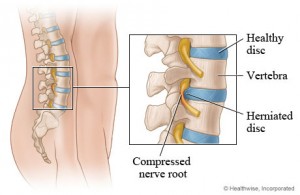A variety of conditions can cause pressure on one or more nerves as they leave your vertebral column in the middle and lower back. And, depending on the cause, the severity of symptoms, also known as “radiculopathies,” can vary.
Symptoms for Nerve Root Impingement
Pressure on the nerve roots often causes what is known as “radicular pain” – that is, pain that seems to come from some distance away from the site of the original problem. This is because the nerves that emerge from your spine form the link between your brain and you outlying tissues: if they are pinched or damaged, you’ll feel pain in the areas that they supply.
The symptoms of nerve root trouble in the middle and lower back can vary from back pain and numbness to nerve pain. Bending forward or sitting tends to relieve the pain of spinal stenosis because this flexed position enlarges the space available for the spinal cord or cauda equina, a bundle of nerves at the end of the cord. There may no symptoms until the condition has been present for some time. In other cases, there’s an immediate onset of pain.
What Causes Impingement on the Nerve Roots?
There are a number of ways a nerve root can become compressed in this area:
Spinal Stenosis

A narrowing of the canal and bony openings (foramina) through which the spinal cord travels and the nerve roots emerge, spinal stenosis can cause a number of nerve root problems in the lumbar spine. The lower part of the lumbar region is more often affected than the upper part.
Spinal stenosis is usually the result of the aging process, when osteoarthritis sets in and your discs become drier and shrink. The growth of bony projections – spurs, called osteophytes, that protrude into the canal and foramina can also contribute to nerve root problems.
Other causes of the spinal stenosis are a herniated or bulging disc, inflamed facet joints, a vertebra that has slipped forward (spondylolisthesis), trauma (such as road accident or fall from a ladder), scoliosis, bone disease, a tumour of the spine, or a congenital defect of the spine, such as a narrower that usual spinal column that has been present from birth.
Slipped Disc and Disc Bulges
Unfortunately poor movement patterns, such as bending with your back rather than your legs o pick up things, can damage the innermost rings of your vertebral discs. The damage gradually spreads to the outer rings, allowing the gel-like fluid in the center to leak out. If the outermost rings are still mainly intact, the fluid causes a bulge, which can press into the central spinal canal or into the space where the nerves leave your spine, and pinch them – causing, for example, problems such as sciatica. If all the rings are damaged, and the fluid seeps out of it, the disc ruptures and “slips” – what doctors call a “prolapse” or “herniation.”
Facet Joint Problems
These tiny joints are located at the back of the vertebrae. They are the joints at which the upper part of each vertebra joins the lower part of one above it, and the lower part joins the upper part of the one below. But if, for example, the lumbar spine loses stability, as a result, say, of poor lifting technique, the fibrous tissue surrounding the facet joints can thicken in an effort to regain stability and protect the area. This can not only pinch nerves as they leave the vertebral column, it can encourage the growth of bony spurs called osteophytes that will also pinch the nerves.
Figuring Out Nerve Root Impingement
Back pain should always be investigated by your doctor. In particular, if you experience bowel and bladder incontinence, severe numbness down the legs, muscle weakness, poor balance, or paralysis, seek immediate medical attention. Following a physical examination, and listening to an account of your symptoms, your doctor will probably be able to make a preliminary diagnosis. An X-ray, CT scan, or MRI of the spine may confirm the precise cause.
Fixing Nerve Root Impingement
Many cases of nerve root inflammation get better without treatment. If this doesn’t happen, the treatment options your doctor may consider include:
- Physiotherapy
This usually involves stretching and strengthening exercises. Posture and movement training are also likely to be included. - Medication
NSAIDs, and injections may be helpful. - Surgery
May be an option to relieve pressure on your spinal cord and/or nerve roots.




